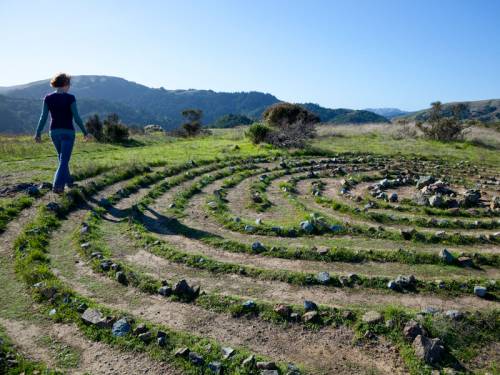EXPLORING SPIRITUAL PRACTICES
Labyrinths grow in popularity
by Rasheeda J. Hastings | Presbyterians Today
 As a spiritual director, I’m often asked about my own spiritual practices. Meditation tops my list. There’s something about the intimacy of personal time spent with the ultimate divine presence that sustains me. While there are many forms of meditation, there’s none quite like meditating as I walk a labyrinth.
As a spiritual director, I’m often asked about my own spiritual practices. Meditation tops my list. There’s something about the intimacy of personal time spent with the ultimate divine presence that sustains me. While there are many forms of meditation, there’s none quite like meditating as I walk a labyrinth.
Labyrinths are circular paths that should not be mistaken or confused for a maze. A maze is designed to trick. Its purpose is for you to lose yourself along the way. A labyrinth, though, helps you find yourself. The Rev. Dr. Lauren Artress, founder of Veriditas, a nonprofit for the education and awareness of labyrinths, has said that the labyrinth is “a blueprint where psyche meets spirit.”
These ancient spiritual paths date as far back as 5,000 years and have been constructed from materials such as brick, stone and grass. Temporary labyrinths can even be made out of some tape on a floor. There are also hand-held labyrinths that you can “walk” by tracing the path with your fingertip. There are a variety of designs as well, from simple four-circuit paths to seven-plus circuits. Many labyrinths were incorporated into the floors of Europe’s great cathedrals in the 12th and 13th centuries. No matter what the physical layout of the labyrinth, they all are a metaphor for life’s journey. Those who walk them come with specific questions, while some seek quiet self-reflection. Walking a labyrinth can be shared with others or experienced alone. People experiencing anxiety or grief often find solace in walking the labyrinth. Caregivers and clergy members often walk a labyrinth to relieve stress, noting a feeling of peace afterward. It is no wonder that companies that sell labyrinths have seen a rise in requests during these COVID days. A 2020 Forbes news report cited labyrinth sales increasing 300% during the height of the pandemic.
I often invite walkers to enter the circle with three “Rs” in mind: release what you are holding, receive what the Spirit is giving you and return with new insights. I often begin by setting an intention, asking, “What is it that I need at this moment? What is my true purpose, and does it please God?” Many times, I offer a prayer in gratitude for the opportunity to pause and allow time to notice the spiritual movement within. More importantly, though, I try not to have expectations — and I have found that the labyrinth experience never disappoints.
Rasheeda J. Hastings is a spiritual director and labyrinth facilitator who resides in Philadelphia.
Learn more
- Read more about the history of labyrinths at labyrinthsociety.org and veriditas.org
- Interested in creating a labyrinth or having one installed? Go to labyrinthcompany.com
- For a quick DIY labyrinth, watch a video at pcusa.info/labyrinth
Support Presbyterian Today’s publishing ministry. Click to give
![]() You may freely reuse and distribute this article in its entirety for non-commercial purposes in any medium. Please include author attribution, photography credits, and a link to the original article. This work is licensed under a Creative Commons Attribution-NonCommercial-NoDeratives 4.0 International License.
You may freely reuse and distribute this article in its entirety for non-commercial purposes in any medium. Please include author attribution, photography credits, and a link to the original article. This work is licensed under a Creative Commons Attribution-NonCommercial-NoDeratives 4.0 International License.